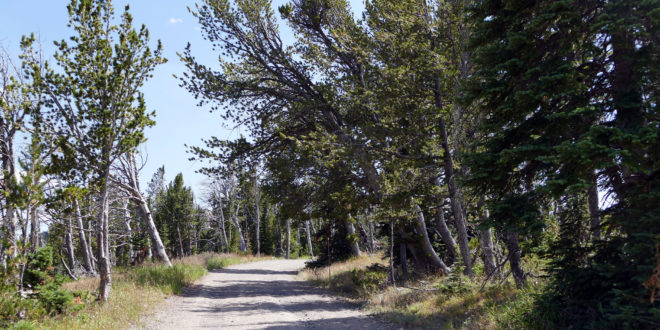A new forest study is using the 1988 Yellowstone fires to map out whether burned forests are more susceptible to bark beetle outbreaks in the future.
According to Phys.org, a new study published earlier this week in the Proceedings of the National Academy of Sciences concludes that large fires curb future bark beetle attacks and “broad-scale outbreaks.”
Another landmark forest study published earlier by the University of Idaho this year definitively linked beetle outbreaks to climate change, saying higher temperatures and less precipitation foster beetle growth—and “synchronize” hatchings in the fall—while milder winters ensure more beetles survive.
In the UI study, a warming climate creates more homogenous conditions, dulling the edge of seasons to create enough temperate stability for beetles to thrive. Inversely, this new study concludes that since fire burns, in effect, randomly, they introduce variability, which beetles don’t like. From Phys.org:
“Fire creates a very heterogeneous landscape,” says study co-author Kenneth Raffa, professor of entomology at the University of Wisconsin-Madison. “Beetles can only reproduce in an individual tree once, so they take advantage of this patch of trees and that patch of trees as they become available, but when the number and size of trees vary a lot, it’s hard for a large outbreak to develop.”
Bark beetles attack trees in order to reproduce, and outbreaks occur primarily in forests in which the beetle’s host trees are large and abundant. It can take decades for young, post-fire trees to reach the size they prefer. But the researchers, including UW-Madison Professor of Zoology Monica Turner, surmised that if large numbers of suitable trees became available at the same time, post-fire forests could become more susceptible to outbreaks.
However, the researchers also considered another possibility: If forests regenerate as mosaics of suitable trees on the landscape (based on size and density), though individual trees may come under attack by bark beetles, this variability might also protect the forest from broad-scale outbreaks.
The study team also includes lead author Rupert Seidl of the University of Natural Resources and Life Sciences in Vienna (who spent his sabbatical at UW-Madison in 2015) and Daniel Donato at the Washington State Department of Natural Resources, a former postdoctoral researcher in Turner’s lab.
As mentioned, the study uses data from the 1988 Yellowstone fires to reach their conclusion. Indeed, as Turner reported to Phys.org, “The Yellowstone Fires are often considered to have ushered in the new era of fire activity in the west.”
Turner and her team simulated growth across 130 years in Yellowstone’s forests following 1988, using a program called the Forest Vegetation Simulator. From Phys.org:
They measured how susceptible the forests would be to bark beetle outbreaks each year following fire based on the characteristics of the dominant tree species in Greater Yellowstone: lodgepole pine and Douglas fir. They compared this to the susceptibility to outbreak assuming the forests regenerated homogenously—in other words, if tree density and size did not vary.
For lodgepole pine, the model showed it would take 79 years for the first post-fire stands to become highly susceptible to bark beetle outbreaks, and 115 years for half of the stands to reach vulnerability. By 130 years, 89 percent of the stands would be at risk of an outbreak.
For Douglas fir, the first stand became vulnerable to bark beetle outbreak after 99 years following the start of post-fire regeneration, according to the model. At 130 years, still just half of the stands were susceptible.
“This variation persists over 130 years,” Turner says. “In contrast, the homogenous stands become vulnerable early and at the same time.”
The researchers documented enormous variability in the tree density, size and growth rates among areas that burned in 1988.
Turner and Raffa advise managers to encourage variability in forest stands and to avoid practices like thinning. Per the researchers, while thinning may make forests look more uniform, they open up stands to risk from beetle outbreaks. Turner and Raffa instead encourage managers to value “dog-hair” stands—short trees grouped closely together—as they may have previously unrecognized ecological roles.
Bark beetles kill western host trees essentially by stressing them to death. Trees already have a line of defense against beetle infestation—they exude a toxic resin to ward off beetles—but said beetles turn that line of defense against them by using pheromones to attract more beetles. More beetles equals more resin, which means the tree stresses itself out even more—which means death. From Phys.org:
Trees that are stressed—through drought, age, defoliation and more—are at increased risk of attack by bark beetles, and subsequently, death. As the climate has warmed, western forests have suffered both an increase in stress and increased beetle overwintering survival, which gives advantage to the bark beetles. The forests have also experienced more frequent and severe fires.
“Climate change is creating more opportunity for beetles,” Turner says. “Because temperatures are warmer, the beetles don’t die off in the winter, and beetles are able to expand their range, impacting trees that are less well-adapted to defending themselves from attack.”
For instance, Raffa says bark beetles have “breached a historical barrier,” showing up in typically cooler places like Alberta, Canada. “The boreal forest now provides a connection between the mountain pine beetle and Midwestern forests for the first time, and no one knows how quickly the beetle will advance or how big a problem it will be,” he says.
Native bark beetles can present problems in Wisconsin, too. Raffa works with the Wisconsin Department of Natural Resources to refine guidelines and perform ongoing research on bark beetles in the state. Some species have long existed here, he says, but they are less aggressive than the species found out west.
 Yellowstone Insider Your Complete Guide to America's First National Park
Yellowstone Insider Your Complete Guide to America's First National Park





